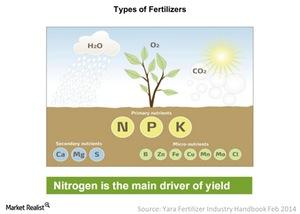Breaking Down Types of Key Fertilizers Used Today
There’s a constant need to bring up the fertility levels necessary to grow crops, and that need is fulfilled by fertilizers.
Jan. 13 2017, Published 8:17 a.m. ET

Fertilizers or nutrients
Crops require water, light, and nutrients for growth. Crops get most of their nutrient requirements from the soil. However, soil composition varies and may not be fully able to provide the necessary nutrients in quantities required by the crops.
Also, continuous farming removes nutrients from the soil. So there’s a constant need to bring up fertility levels necessary to grow crops, and that need is fulfilled by fertilizers.
Sources of nutrients
Nutrients can be obtained from organic or manufactured sources (SOIL). Organic nutrients can come from waste such as compost, while manufactured nutrients are industrially produced or extracted from minerals. For the purpose of this series, we’ll only talk about manufactured nutrients.
Manufactured agricultural nutrients can be in a solid, liquid, or gaseous state. They’re broadly classified into the following two categories:
- macronutrients
- micronutrients
Macronutrients
Macronutrients are nutrients required by plants in large quantities, and thus the name macronutrients. Macronutrients are classified into the following two categories:
- primary macronutrients
- secondary macronutrients
Nitrogen, phosphorous, and potassium, commonly abbreviated NPK to match their letters on the periodic table, are the most important macronutrients for plants. Ca (calcium), Mg (magnesium), and S (sulfur) are plants’ secondary macronutrients.
PotashCorp (POT), Mosaic (MOS), Agrium (AGU), and CF Industries (CF) produce some of the above macronutrients.
Micronutrients
Micronutrients are nutrients required by plants in smaller quantities. B (boron), Cl (chlorine), Mn (manganese), Fe (iron), Cu (copper), Zn (zinc), Ni (nickel), and Mo (molybdenum) are the micronutrients required to grow plants.
NPK macronutrients are used the most. Let’s move on to the next part to find out more about this important fertilizer.
